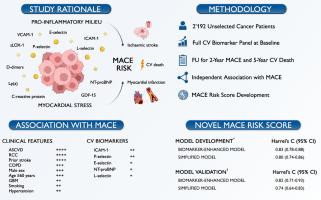癌症患者生物标志物增强心血管风险预测:一项前瞻性队列研究。
IF 5
2区 医学
Q1 HEMATOLOGY
引用次数: 0
摘要
背景:癌症特异性生存率的不断提高使越来越多的癌症患者面临重大不良心血管事件(MACE)的风险,但目前仍缺乏量身定制的心血管风险预测工具:评估一系列心血管生物标志物和风险因素,以预测癌症患者的 MACE 和心血管死亡:方法:共对2192名新确诊或复发癌症患者进行了前瞻性随访,以观察2年MACE和5年心血管死亡的发生情况。拟合了单变量和多变量风险模型,以评估心血管风险因素和生物标志物与不良结局的独立关联,并制定了风险评分:结果:传统的心血管风险因素和某些癌症类型与较高的MACE风险有关。虽然脂蛋白(a)、CRP和GDF-15的水平与MACE无关,但ICAM-1、P-/E-/L-选择素和NT-proBNP的水平与2年MACE风险独立相关。得出的临床风险评分为:男性、吸烟和年龄≥60 岁+1 分,动脉粥样硬化性疾病+2 分,预测 2 年 MACE 的自引导 C 统计量为 0.76(95% CI:0.71-0.81)。生物标志物数据的应用提高了预测效果(0.83,95% CI:0.78-0.88),简化模型的预测效果与之相似(0.80,95% CI:0.74-0.86)。在预测5年心血管死亡方面,生物标志物增强预测模型和简化预测模型的C统计量分别为0.82(95% CI:0.71-0.93)和0.74(95% CI:0.64-0.83):结论:生物标志物增强风险预测策略可识别出MACE和心血管死亡风险较高的癌症患者。虽然外部验证研究仍在进行中,但这一首创的风险评分可为跨癌症实体的个性化心血管风险评估奠定基础。本文章由计算机程序翻译,如有差异,请以英文原文为准。

Biomarker-enhanced cardiovascular risk prediction in patients with cancer: a prospective cohort study
Background
Continuously improving cancer-specific survival puts a growing proportion of cancer patients at risk of major adverse cardiovascular events (MACE), but tailored tools for cardiovascular risk prediction remain unavailable.
Objectives
To assess a broad panel of cardiovascular biomarkers and risk factors for the prediction of MACE and cardiovascular death in cancer patients.
Methods
In total, 2192 patients with newly diagnosed or recurrent cancer were followed prospectively for the occurrence of 2-year MACE and 5-year cardiovascular death. Univariable and multivariable risk models were fit to assess independent associations of cardiovascular risk factors and biomarkers with adverse outcomes, and a risk score was developed.
Results
Traditional cardiovascular risk factors and selected cancer types were linked to higher MACE risk. While levels of Lp(a), CRP, and GDF-15 did not associate with MACE, levels of ICAM-1, P-/E-/L-selectins, and NT-proBNP were independently linked to 2-year MACE risk. A clinical risk score was derived, assigning +1 point for male sex, smoking, and age of ≥60 years and +2 points for atherosclerotic disease, yielding a bootstrapped C-statistic of 0.76 (95% CI: 0.71-0.81) for the prediction of 2-year MACE. Implementation of biomarker data conferred improved performance (0.83, 95% CI: 0.78-0.88), with a simplified model showing similar performance (0.80, 95% CI: 0.74-0.86). The biomarker-enhanced and simplified prediction models achieved a C-statistic of 0.82 (95% CI: 0.71-0.93) and 0.74 (95% CI: 0.64-0.83) for the prediction of 5-year cardiovascular death.
Conclusion
Biomarker-enhanced risk prediction strategies allow the identification of cancer patients at high risk of MACE and cardiovascular death. While external validation studies are ongoing, this first-of-its-kind risk score may provide the basis for personalized cardiovascular risk assessment across cancer entities.
求助全文
通过发布文献求助,成功后即可免费获取论文全文。
去求助
来源期刊
CiteScore
24.30
自引率
3.80%
发文量
321
审稿时长
1 months
期刊介绍:
The Journal of Thrombosis and Haemostasis (JTH) serves as the official journal of the International Society on Thrombosis and Haemostasis. It is dedicated to advancing science related to thrombosis, bleeding disorders, and vascular biology through the dissemination and exchange of information and ideas within the global research community.
Types of Publications:
The journal publishes a variety of content, including:
Original research reports
State-of-the-art reviews
Brief reports
Case reports
Invited commentaries on publications in the Journal
Forum articles
Correspondence
Announcements
Scope of Contributions:
Editors invite contributions from both fundamental and clinical domains. These include:
Basic manuscripts on blood coagulation and fibrinolysis
Studies on proteins and reactions related to thrombosis and haemostasis
Research on blood platelets and their interactions with other biological systems, such as the vessel wall, blood cells, and invading organisms
Clinical manuscripts covering various topics including venous thrombosis, arterial disease, hemophilia, bleeding disorders, and platelet diseases
Clinical manuscripts may encompass etiology, diagnostics, prognosis, prevention, and treatment strategies.

 求助内容:
求助内容: 应助结果提醒方式:
应助结果提醒方式:


